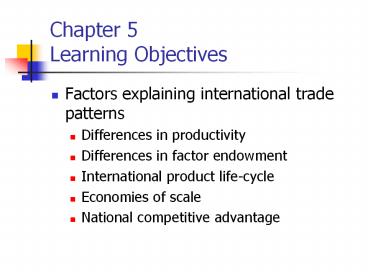Chapter 5 Learning Objectives - PowerPoint PPT Presentation
1 / 11
Title:
Chapter 5 Learning Objectives
Description:
Chapter 5 Learning Objectives Factors explaining international trade patterns Differences in productivity Differences in factor endowment International product life-cycle – PowerPoint PPT presentation
Number of Views:114
Avg rating:3.0/5.0
Title: Chapter 5 Learning Objectives
1
Chapter 5Learning Objectives
- Factors explaining international trade patterns
- Differences in productivity
- Differences in factor endowment
- International product life-cycle
- Economies of scale
- National competitive advantage
2
Learning Objectives
- Implications for business suggested by each of
the theories - Cost of production
- Low cost location
- First mover advantage
- Resource allocation
- Government policy
3
Chapter Focus
- Review several trade theories that explain why it
is beneficial for a country to engage in
international trade. - Explain the pattern of international trade
observed in the world economy.
4
Chapter 4
International Trade Theory Various explanations
are given to rationalize the observed patterns of
international trade.
Adam Smith Absolute Advantage Free Trade, Least Govt. Intervention
David Ricardo -Comparative Advantage -Gains from trade arising from differences in productivity Unrestricted Free Trade Increase in World Production
Hecksher-Olin Theory Comparative Advantage arises from differences in National Factor Endowments Free Trade Beneficial
5
Absolute Advantage
Ghana S.Korea Cocoa10 res./unit Cocoa40
res./unit Rice20 res./unit Rice10
res./unit Ghana has an absolute advantage in
cocoa and S. Korea has an absolute advantage in
rice.
6
Absolute Advantage (cont)
- Effect of Trade Increase Total Production
- Increase Total Consumption
- Specialization
- Trade is a positive sum game
7
Comparative Advantage
- Differences in Labor Productivity
Ghana- more efficient in both cocoa and
rice Absolute advantage in both, but has a
comparative advantage in cocoa. It produces 4
times as much cocoa as S.Korea, but 1.5 times as
much rice. Why should Ghana trade? Total
Production Total Consumption
G
20
10
K
K
G
20
10
8
Heckscher-Olin Theory
- Comparative Advantage arises from differences in
national factor endowments. - Countries export the products that use the
resources or factors that are abundant. - Leontiefs Paradox
- How do you explain
- The U.S. exports commercial aircrafts and
imports automobiles?
9
1. The Product Life Cycle Theory
- New products introduced in the U.S. and exported
to advanced countries. - Overtime, as demand increases advanced countries
produce for their home markets. Also, the U.S.
firms set up production facilities in advanced
countries - U.S. exports are limited
- As the market in the U.S. and other advanced
countries matures, the product becomes more
standardized. Cost considerations play an
important role. Countries with lower cost
(Italy, Spain) export to the U. S. - Developing Countries like Thailand start
acquiring cost advantage factories - Exports from Thailand (pg. 136 chart)
10
2. New Trade Theory
- Paul Krugman (M. I. T.) developed a new trade
theory - Countries specialize in the production and
export of products not because of factors
endowments but because in some industries world
market can support only a limited number of
firms - First-mover advantage
- The firm builds a competitive advantage by being
the first (Boeing in com. Jet aircraft). Other
countries with similar factor endowment find it
difficult to produce. - Specialization, economies of scale and demand
conditions - Role for subsidies or selective government
intervention
11
3. Porters Diamond
- Michael Porter of Harvard Business School
published a book in 1990 - Competitive Advantage of Nations
- Why does a country achieve international success
in a particular industry? - Ex. Japan Automobiles
- SwitzerlandPrecision Instruments
- U.S.A. Chemicals
- H/O Theory cannot explain some of these
patternspartial explanation - Four attributes create or impede competitive
advantage - 1. Factor Endowments
- 2. Demand Conditions
- 3. Related and Supporting Industries
- 4. Firm Strategy, Structure and Rivalry
- Two additional Factors
- Chanceopportunities
- GovernmentAnti-trust policy, Inv. In Education

